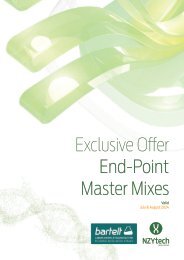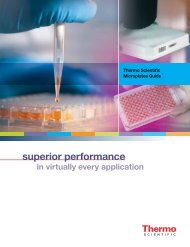PeloBiotech
You also want an ePaper? Increase the reach of your titles
YUMPU automatically turns print PDFs into web optimized ePapers that Google loves.
www.pelobiotech.com<br />
• May require additional optimization for specific cell types.<br />
• Availability may be limited compared to FBS.<br />
•<br />
Animal Origin-Free Media<br />
Animal origin-free (AOF) media, on the other hand, prioritizes the exclusion of any components sourced directly from<br />
animals, such as serum, addressing ethical concerns, regulatory constraints, and contamination risks. While AOF media<br />
eliminates the use of animal-derived products, it may still contain complex, chemically defined components. This broader<br />
category provides an alternative for researchers seeking to create a culture environment free of animal-origin components<br />
while allowing for flexibility in the specific formulation.<br />
Advantages:<br />
• Completely devoid of any animal-derived components, addressing ethical concerns and regulatory<br />
considerations.<br />
• Reduced risk of introducing contaminants from animal sources, ensuring a cleaner and more controlled culture<br />
environment.<br />
• Suitable for applications where the presence of animal-derived components is restricted, such as in the<br />
production of therapeutic proteins for human use.<br />
Disadvantages:<br />
• Can be more expensive compared to media containing animal-derived components.<br />
• May require additional optimization for specific cell types, as the absence of certain factors present in animalderived<br />
products may impact cell growth or function.<br />
• Availability of well-defined formulations for all cell types may be limited.<br />
Defined Media<br />
Defined media represent a meticulous approach to cell culture formulation, offering researchers precise control over every<br />
component's composition. By excluding undefined or complex components, defined media eliminate batch variability,<br />
ensuring reproducibility in experimental outcomes. This level of specificity is particularly advantageous for detailed<br />
research where a clear understanding and manipulation of the nutritional and signaling factors influencing cell behavior<br />
are crucial. Defined media are ideal for experiments requiring consistency, allowing researchers to tailor the culture<br />
environment with exacting precision.<br />
Advantages:<br />
• Offers precise control over the composition of the media, allowing for reproducibility and consistency between<br />
batches.<br />
• Eliminates batch-to-batch variability associated with complex, undefined components, promoting reliability in<br />
experimental outcomes.<br />
• Ideal for research where a clear understanding and manipulation of individual components are crucial.<br />
Disadvantages:<br />
• More expensive compared to media containing complex, undefined components.<br />
• Optimization may be required for specific cell types, as the absence of certain factors present in undefined<br />
media might affect cell behavior.<br />
• The formulation process can be complex, requiring careful consideration of the nutritional needs of the cells.<br />
28
















